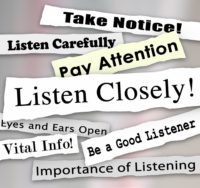The power of (active) listening
19/05/2018 - By Ellen Onkelinx - Founder master the gap®Have you experienced a conversation where the other side is essentially waiting for you to stop talking so they can share their own point of view?
Indeed, many people do not listen to understand, they listen to reply.
Listening to the other side and understanding where they are coming from, however, are crucial for a successful negotiation.
From talking to listening
The Dalai Lama rightfully said:
"When you talk, you are only repeating what you already know. But if you listen, you might learn something new.”
Listening unlocks value

There is a difference between merely hearing what someone is saying and listening. When you are actually listening, you are trying to understand the complete message the other side is trying to bring across and not just hearing the words.
To create value, especially when you are negotiating, you must try to understand what the other side is after. Therefore, take the time to find out why someone is defending a position and carefully listen to what they really want to say.
Some people are reluctant to trying to understand the other side because they fear it might weaken their own negotiation power. However, understanding the other side does not mean you also have to agree with their point of view.
Truly understanding the underlying motives, needs and concerns behind someone’s position will on the contrary help you to unlock value, bridge a gap and get the most out of a negotiation.
Splitting the pumpkin
Imagine 3 sisters fighting over a pumpkin. There is only 1 pumpkin and all 3 sisters want to have it. The tension is rising.
What would you suggest they do?
Most people will suggest they split the pumpkin in 3 equal pieces. The 3 sisters then go home with their equal piece of the pumpkin.
- The first sister uses the flesh to cook pumpkin soup and throws away the rest.
- The second sister uses the seeds for a salad and throws away the rest.
- The third sister uses the skin to carve out a Halloween head and throws away the rest.
It is clear that, if you had taken the effort to inquire about their motives and listen to each of the 3 sisters’ needs, the outcome of the discussion would have been completely different and each of them would have fully met their interests rather than settle for an unsatisfying compromise.
From listening to active listening

A skillful negotiator does not only listen. He/she also engages in active listening and makes sure the other side will actually also feel understood. Because, when someone feels understood, they are more likely to get into a cooperative and problem-solving mindset.
There are many ways to demonstrate active listening, one of them is “the loop of understanding”.
The loop of understanding
Rather than telling, arguing and defending your position during a negotiation you could inquire about, listen to and paraphrase the other side’s interests. Robert H. Mnookin, professor at Harvard Law School, calls this the “loop of understanding”.
The loop of understanding is a technique that demonstrates understanding and empathy with the other party.
- You start off by inquiring about an issue with the other person.
- You listen to the response.
- Finally, you demonstrate your understanding of the response by paraphrasing it and checking with the other person whether this understanding is correct. If there are emotions involved, you acknowledge these emotions without feeding them.
If applied correctly, looping can help you clarify your own understanding of the interests involved, and at the same time demonstrate to the other side that you understand their point of view, while also defusing possible negative emotions.
From active listening to combining empathy and assertiveness

Of course, when you negotiate, you want to get the best possible result for you and your company. Therefore, you need to be assertive and effectively advocate for your own interests and needs too. Every negotiation, especially those involving a lasting business relationship, holds a tension between being assertive and showing empathy.
Try to combine assertiveness with empathy and active listening. Explain your own interests clearly and check the other side’s understanding of your story. Lead by example by inspiring openness and cooperation and by showing empathy.
And be flexible… if needed, adjust your own behavior and change the game (for example by being more empathic or more assertive).
Negotiation is about finding a balance… a balance between being assertive and showing empathy and also a balance between claiming value and creating it… but that will be for a next blog!
If you want to learn more about negotiation, visit the master the gap website or get in touch.